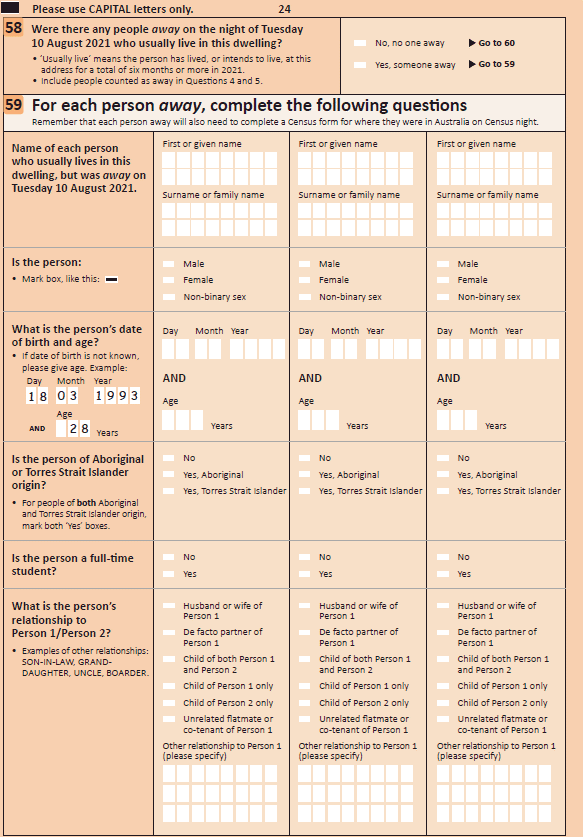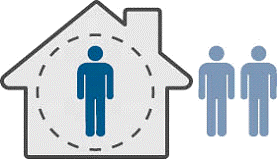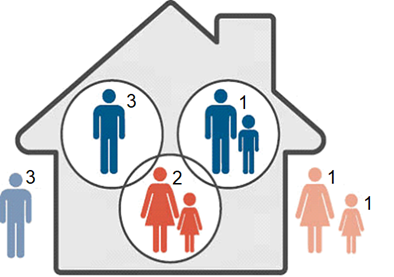Persons temporarily absent
Exploring how data on people who are away from home is collected and used
How we use information on people away from home on Census Night
The Census collects information on all people who were at home on Census Night and allows for up to three people who were away from home to be recorded at a residence.
The information we collect for people who were away from home on Census Night includes:
- age (AGEP)
- sex (SEXP)
- Indigenous status (INGP)
- relationship to Person 1/Person 2 (RLHP)
- full-time/part-time student status (STUP).
We use this basic information to determine the structure of a household. For example, whether it is made up of families or people who are unrelated.
Persons temporarily absent on the Census form
Image

Description
We refer to people who are away from home on Census Night as Persons temporarily absent.
We have six variables for Persons temporarily absent that you can use with Census data. Five relate to different kinds of people absent from the family, and one is used to count the number of people absent from the household.
More information on these variables can be found in the 2021 Census Dictionary.
Absent from family variables
Absent from household variables
- Count of persons temporarily absent from household (CPAD).
Examples of how information on temporarily absent people is used
Here are some examples of how we use information on temporarily absent people to decide the type of household or family who usually lives in a dwelling.
Example 1: The location of spouse (SPLF) is temporarily absent
Image

Description
A parent and two children were at home on Census Night and one parent was away from home (SPLF).
Instead of Family composition (FMCF) being recorded as a One parent family, we use the information about the temporarily absent spouse (in the ‘person away’ section of the form) to code the family as a Couple family with children.
The Household composition (HHCD) was One family household.
The Count of persons temporarily absent from family (CPAF) and the household (CPAD) was one.
Example 2: Unrelated and absent individual
Image

Description
One adult was at home and two unrelated adults were away on Census Night.
Instead of Household composition (HHCD) being recorded as a Lone person household, we use the information about the absent people to code this as a Group household.
The Count of persons temporarily absent from household (CPAD) was two.
The Count of persons absent from the family (CPAF) was not applicable for this household because it is not a family household.
Example 3: Multiple family household with family members temporarily absent
Image

Description
The numbers in the diagram are Family numbers (FNOF).
In the primary family there was an adult and child at home and an adult and child away.
The second family had an adult and child at home. There was no one away from home.
In the third family one adult was at home and one adult was away from home.
Using the relevant variables, and the information provided on the Census form for the three temporarily absent people, we can determine the following information about these families.
The Household composition (HHCD) is a Three family household.
The Count of persons temporarily absent from household (CPAD) was three.
| Primary family (FNOF 1) | Second family (FNOF 2) | Third family (FNOF 3) | |
|---|---|---|---|
| Family composition (FMCF) | Couple family with children under 15 years | One parent family with a child under 15 years | Couple family without children |
| Count of persons temporarily absent from family (CPAF) | Two persons temporarily absent from family | No persons temporarily absent from family | One person temporarily absent from family |
| Location of spouse (SPLF) | Temporarily absent | N/A | Temporarily absent |
| Count of non-dependent children temporarily absent (CNDAF) | N/A | N/A | N/A |
| Count of dependent children under 15 years temporarily absent (CDCAF) | One dependent child under 15 years temporarily absent | N/A | N/A |
| Count of dependent students (15-24 years) temporarily absent (CDSAF) | N/A | N/A | N/A |
Why are temporarily absent variables necessary?
There are three main reasons why we collect data on persons who are away from home on Census Night:
- For greater accuracy in coding families and households
- To count the number of usual residents per household
- To perform calculations such as the average number of people per household
Place of usual residence (PURP)
Place of usual residence (PURP) is a person level variable that allows counts of people by the place where they usually live rather than by where they were counted on Census Night.
We use Place of usual residence in the processing and calculation of Count of persons temporarily absent from household (CPAD).
Please see Comparing Place of usual residence with Place of enumeration for further information.
Usual address indicator Census Night (UAICP)
Usual address indicator Census Night (UAICP) is a variable that indicates whether a person was at home or elsewhere in Australia on Census Night.
You can use this variable to exclude temporarily absent persons from Place of enumeration data.
COVID-19 effects on Persons temporarily absent
The 2021 Census was conducted during the COVID-19 pandemic, which required much of the Australian population to isolate at home under health directives. A slightly higher proportion of the population were at home on Census Night than in the previous Census. This was more noticeable in NSW and Victoria as large parts of these states were in lockdown at the time of the 2021 Census.
| New South Wales | Victoria | Queensland | South Australia | Western Australia | Tasmania | Northern Territory | Australian Capital Territory | Australia(a) | |
|---|---|---|---|---|---|---|---|---|---|
| 2021 | |||||||||
| At home | 96.8% | 97.3% | 94.6% | 96.0% | 93.7% | 95.5% | 81.5% | 96.6% | 95.9% |
| Elsewhere in Australia | 3.0% | 2.5% | 5.1% | 3.8% | 6.0% | 4.3% | 17.3% | 3.1% | 3.9% |
| Total(b) | 100.0% | 100.0% | 100.0% | 100.0% | 100.0% | 100.0% | 100.0% | 100.0% | 100.0% |
| 2016 | |||||||||
| At home | 94.5% | 95.2% | 91.9% | 94.9% | 92.8% | 94.6% | 82.2% | 94.1% | 93.9% |
| Elsewhere in Australia | 4.2% | 3.6% | 6.4% | 4.2% | 6.0% | 4.8% | 14.3% | 4.6% | 4.8% |
| Total(b) | 100.0% | 100.0% | 100.0% | 100.0% | 100.0% | 100.0% | 100.0% | 100.0% | 100.0% |
(a) Includes Other territories
(b) Includes Overseas visitors
Source: Count of persons temporarily absent from household (CPAD).